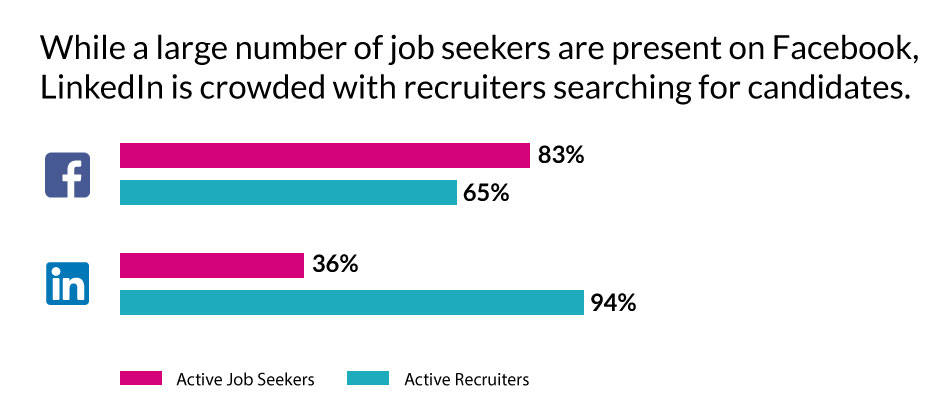Topics: Candidate Sourcing, Talent Acquisition, Talent Advisory, Talent Management
4 Passive Candidate Sourcing Best Practices You Can Start Today
Posted on March 02, 2020
Written By Aron Vaidya

Getting active candidates is easy! I can easily access copious amounts of talent from job portals and job boards. Why bother with passive candidates? Is it worth the extra strenuous effort?
Consider the following numbers,
70% of the existing global workforce is comprised of passive candidates who aren’t seeking new opportunities proactively. (LinkedIn)
The current market is suffering from skills shortages. 72.8% of employers are finding it challenging to hire skilled candidates, and 45% are worried about their ability (or lack of it) to find staff with the required skills. (Manpower Group)
The challenge to find the purple squirrel and unicorn is far greater than ever. In this scenario, it has become far more critical for recruitment and staffing firms to ensure that they have an appropriate candidate sourcing strategy in place, inclusive of most effective passive candidate techniques.
What are Passive Candidates?
Passive candidates are candidates who are not actively seeking new job opportunities. That doesn’t mean we’re implying that these candidates are not open to new job opportunities. Here, factors like your persuasion skills, your emotional intelligence, and your ability to provide exceptional candidate experience come into play to entice this potential purple squirrel to apply for the position you have in hand.
In this piece, we’ll talk about passive candidate sourcing strategies, tips, tricks, and best practices. Regardless of what you call it, the following points should help you upskill your talent sourcing workforce.
Here’s what you must do to attract passive candidates to your job openings:
1. Talk to Passive Candidates

This step sounds simple, right? You’re not entirely wrong. But here’s where most sourcing experts and recruiters fail. When we say talk, we don’t mean a talk in which you inform them about a potential job opening, they respond with a no, you ask for references, and in return receive another resounding no. When we say “talk” to them, we mean “hold an engaging conversation” with them.
Ian Knowlson, a global recruitment influencer, pointed out that holding a conversation, encompassing persuasiveness and emotional intelligence, is what separates humans from AIs. It’s why AIs are still many years away from developing a capability to take up sourcing duties. It may also be insinuated that you might as well be a robot reciting a pre-defined script if you don’t use your human ability to converse with your candidates.

Following tips should help you make your minutes count while convincing a passive candidate:
- Make sure you have complete information about the job and the candidate before you call.
- Identify and use your unique selling points (USPs) and appealing aspects of what you have on offer.
- Identify candidate’s pain-points and motivators. It could be a higher salary, upskill opportunity or the prospect of a better work-life balance
- Get them to talk more; be a better listener.
- Do not ask about salary or negotiate in your first call.
These are but a few points that can help you carry an engaging conversation with passive resources. For more detailed insights, we recommend reading Lou Adler’s blogs on engagements with passive talents.
Here’s one that relates to the current topic:
5 Most Important Minutes of Talking to a Passive Candidate
We’d like to focus a bit more one of the points highlighted above: Focus on pain-points and motivators
Passive candidates will only be ready to make a move if they believe that the new role is more rewarding than the current one. These rewards can be in the form of
- Increase in compensation and benefits (works more often than not)
- Healthier work-life balance
- Improved growth potential
- Fun company culture
- Better upskilling and learning prospect
- Flexible work arrangements
Millennials aren’t in interested in information about requirements and designation only; they are more inclined to know about company culture, career growth, and the employer brand.
This practice may seem easy-breezy, but it will test your charisma, intelligence and ability to think on your feet.
Now, that you know how to speak with them, let’s focus on approaches you must take to find passive candidates:
Before you set out on your search for a passive candidate online, check the database you (may) have built throughout the years in your ATS. It could be swarming with passive resources you’ve engaged in the past. If you provided a great candidate experience during the earlier engagement, they would listen to what you have on offer. Even if they aren’t available, they’ll more likely direct you to new passive talent in the form of referrals.
2. Use Referrals
Referral hiring is one of the most utilised sourcing techniques in modern recruitment landscape. A well-planned referral program not only helps you connect to more number of passive candidates but also enables you to source high-quality candidates. This point has been further validated by a LinkedIn report which states that employee referrals are a top source for high-quality hires.

Referral Network
The passive talent engaged through referrals will be more approachable and swayable. They may be hesitant to respond to an email from an unknown sourcer, but they’ll most likely listen to what you have to say and consider the proposed opportunity if it comes to them through a familiar connection.
Adopt this tactic in your all sourcing practices. You can get quality referrals from your employees, third-party recruiters, social media, offline network and your candidates. An incentivised referral program is a great plan to build a pool of passive talent.
3. Visit Industry-Specific Work Sample Sites
There are candidates not found on any CV database websites, nor are they inclined to respond to job adverts and posts. However, the probability of finding them hanging out at their specific online portfolio sites is quite high.
Are you looking for a designer? Visit work sample sites such as Behance, Unsplash or Dribble.
Are you looking for a developer? Go to GitHub, HackerRank or SourceForge platforms.
Are you looking for a healthcare professional? Browse through Sermo, DoctorsHangout or AllNurses.
You can also join industry-specific groups on social media platforms such as LinkedIn and Facebook to connect with relevant specialists.
4. Leverage Targeted Social Media platforms

As a sourcer, we are sure you’ve already been asked by your manager to use LinkedIn as a go-to social media recruiting channel, but, lately, it’s grown to become so oversaturated with recruiters and sourcers that sourcing passive talent there has become highly challenging and less effective.

We still like LinkedIn and don’t believe, in the slightest, that you should do away with it from your passive candidate sourcing strategy. However, it’s time for expansion and exploration of other social media platforms:
Facebook:
Compared to LinkedIn’s 310 monthly active users (MAU), Facebook boasts over 2.50 billion monthly active users. Facebook is a goldmine of passive candidates, and through its targeted search capabilities, you can find the rarest relevant talent in the market. Moreover, this platform will allow you to gauge and determine if the potential hire is a cultural fit for your organisation.
Twitter:
Twitter features search functionality that allows you to search for users through industry-specific hashtags. Looking to hire a content marketer? Use the keywords “content” and “strategy” or any other keywords pertaining to your requirement using Twitter’s advanced search. Need someone local? Select the “Near you” option, and you should be presented with profiles of local Twitter users tweeting about content strategies and may potentially fit your required candidate profile. This platform also offers less sourcing competition compared to Facebook and LinkedIn.
Other Social Media platforms to consider:
- Snapchat
- Quora
- Industry-specific portfolio and networking sites such as Pinterest, Github or DoctorsHangout
When you approach passive talent through social media, make sure you don’t spam their inbox with robotic job ads. Be persistent, but be smart about it. Be kind and respectful. There is a thin line between persistence and nuisance. You don’t want them to feel that you are invading their privacy. There are stringent international laws in place to safeguard users’ online privacy rights.
Conclusion
Sourcing passive candidates may be a bit more challenging than sourcing active candidates. But, knowing the right passive talent sourcing techniques will help you make headway in crowded recruitment competition. All it takes is your commitment to the four steps mentioned above, and you’ll find success in passive candidate sourcing.

QX RPO UK Services is one of the most preferred passive candidate sourcing companies for recruitment agencies based in the UK. Contact us for more information.

Originally published Mar 02, 2020 12:03:41, updated Dec 20 2024
Topics: Candidate Sourcing, Talent Acquisition, Talent Advisory, Talent Management







